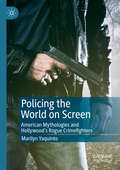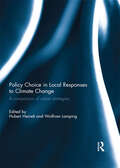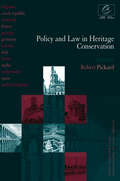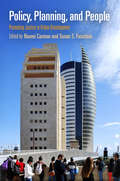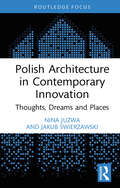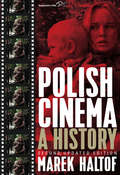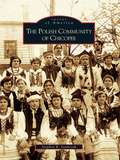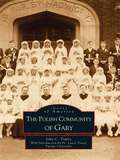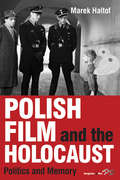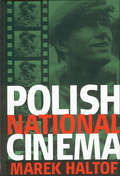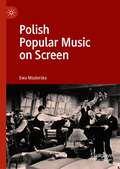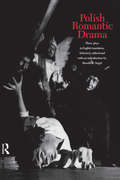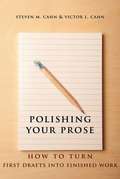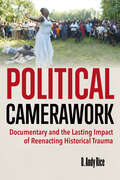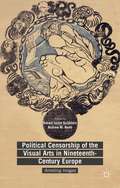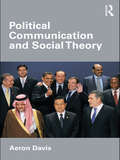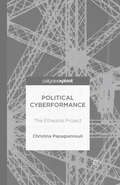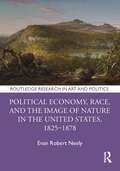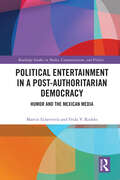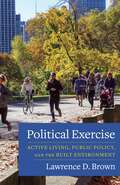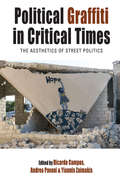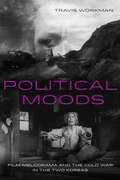- Table View
- List View
Policing the World on Screen: American Mythologies and Hollywood's Rogue Crimefighters
by Marilyn YaquintoThis book analyzes Hollywood storytelling that features an American crimefighter—whether cop, detective, or agent—who must safeguard society and the nation by any means necessary. That often means going “rogue” and breaking the rules, even deploying ugly violence, but excused as self-defense or to serve the greater good. This ends-justifies-means approach dates back to gunfighters taming the western frontier to urban cowboy cops battling urban savagery—first personified by “Dirty” Harry Callahan—and later dispatched in global interventions to vanquish threats to national security. America as the world’s “policeman often means controlling the Other at home and abroad, which also extends American hegemony from the Cold War through the War on Terror. This book also examines pioneering portrayals by males of color and female crimefighters to embody such a social or national defender, which are frustrated by their existence as threats the white knight exists to defeat.
Policy Choice in Local Responses to Climate Change: A Comparison of Urban Strategies
by Hubert Heinelt and Wolfram LampingSince the 1990s ‘beliefs’, ‘ideas’ or ‘knowledge’ as well as processes of communicative interactions such as persuasion, argumentation and learning have received increasing attention in social science for the understanding of political changes. This book makes a significant contribution to this scholarly debate and will be of interest to practitioners, showing on one side how climate change has received more and more attention in policy making at the local level and changed the urban agenda and on the other how different the responses of cities to this global challenge are – and how these differences between cities can be explained. This book was previously published as a special issue of Urban Research and Practice.
Policy and Law in Heritage Conservation (Conservation Of The European Built Heritage Ser.)
by Robert PickardThis book has been developed in association with the Cultural Heritage Department of the Council of Europe. It examines key themes and objectives for the protection of the architectural and archaeological heritage in a range of European countries. The analysis of individual countries and the group as a whole gives an assessment of how advanced current mechanisms are and the ongoing problems that remain to be managed in order to safeguard the 'common heritage'.
Policy, Planning, and People
by Susan S. Fainstein Naomi CarmonThe contributors of Policy, Planning, and People argue for the promotion of social equity and quality of life by designing and evaluating urban policies and plans. Edited by Naomi Carmon and Susan S. Fainstein, the volume features original essays by leading authorities in the field of urban planning and policy, mainly from the United States, but also from Canada, Hungary, Italy, and Israel. The contributors discuss goal setting and ethics in planning, illuminate paradigm shifts, make policy recommendations, and arrive at best practices for future planning.Policy, Planning, and People includes theoretical as well as practice-based essays on a wide range of planning issues: housing and neighborhood, transportation, surveillance and safety, the network society, regional development and community development. Several essays are devoted to disadvantaged and excluded groups such as senior citizens, the poor, and migrant workers. The unifying themes of this volume are the values of equity, diversity, and democratic participation. The contributors discuss and draw conclusions related to the planning process and its outcomes. They demonstrate the need to look beyond efficiency to determine who benefits from urban policies and plans.Contributors: Alberta Andreotti, Tridib Banerjee, Rachel G. Bratt, Naomi Carmon, Karen Chapple, Norman Fainstein, Susan Fainstein, Eran Feitelson, Amnon Frenkel, George Galster, Penny Gurstein, Deborah Howe, Norman Krumholz, Jonathan Levine, Anastasia Loukaitou-Sideris, Enzo Mingione, Kenneth Reardon, Izhak Schnell, Daniel Shefer, Michael Teitz, Iván Tosics, Lawrence Vale, Martin Wachs.
Polish Architecture in Contemporary Innovation: Thoughts, Dreams and Places
by Nina Juzwa Jakub ŚwierzawskiAuthored by two architects, Polish Architecture in Contemporary Innovation: Thoughts, Dreams and Places tells a story of buildings that were built in Poland between 1980 and 2020, as architecture developed in the Western world and Japan. Its main focus is public utility buildings which the authors “have touched” in situ and which have moved them or sparked their interest. The book is divided into three parts: • Part I focuses on the problem of creating and shaping architectural form and uses examples of both international and Polish architecture. In this section, the authors pose the question: why is the Pritzker Prize so important? • Part II attempts to answer the question of how architecture can change the image of a place. The answer consists of mainly Polish examples of user-friendly architecture, value, and beauty in architecture and place. • Part III analyses buildings that were created in contemporary Poland. Examples are listed in groups, according to their function, pointing out forms that were inspired by the culture of the region, the historical culture of the place, or those which are a new quality and are the foundation of the creation of a place. This book aims to demonstrate Polish architectural solutions in the context of contemporary trends in the West, traditionally seen as more technically and technologically developed countries. The floor plans and sections of the buildings presented in the book show the beauty of geometric and formal solutions and give a new and rare perspective on the latest changes in modern Polish architecture. This book will be of interest to architects as well as researchers and students of contemporary Polish architecture and culture and its place in the European and international context. The Polish edition of this book, published in 2021 by the National Institute of Architecture and Urban Planning in Warsaw, received the Vitruvius Prize 2022 by the Architecture and Urban Planning Committee of the Polish Academy of Sciences.
Polish Cinema: A History
by Marek HaltofFirst published in 2002, Marek Haltof’s seminal volume was the first comprehensive English-language study of Polish cinema, providing a much-needed survey of one of Europe’s most distinguished—yet unjustly neglected—film cultures. Since then, seismic changes have reshaped Polish society, European politics, and the global film industry. This thoroughly revised and updated edition takes stock of these dramatic shifts to provide an essential account of Polish cinema from the nineteenth century to today, covering such renowned figures as Kieślowski, Skolimowski, and Wajda along with vastly expanded coverage of documentaries, animation, and television, all set against the backdrop of an ever-more transnational film culture.
Polish Community of Chicopee, The
by Stephen R. JendrysikThe first group of Polish immigrants to come to Chicopee arrived in 1880. These Poles filled many of the manufacturing jobs in the city's two large textile mills. In less than 30 years from their arrival, this aggressive, self-assured group boasted more Polish-owned businesses than any other community in New England. The Polish Community of Chicopee chronicles an immigrant population that was fiercely dedicated to the ideals of free enterprise and democratic pluralism.
Polish Community of Gary, The
by John C. Trafny Dr Lance TrustyThe Polish Community of Gary is a vibrantly illustrated tale of the history of the Midwest's Steel City and its Polish-Catholic residents. It reveals the journey of hopeful and hard-working Polish immigrants who arrived in the early 1900s, established an ethnic community, and adapted to the American way of life. This fascinating photographic compilation of almost 200 images features various past and present residents of Gary. It examines the city's diverse ethnic groups and religious denominations, offering a glimpse of a life very different from that of today. Along with detailed captions, The Polish Community of Gary offers the rare chance to experience the history of Polish Gary, bringing its exciting past alive again. Author John Trafny traces the story of past trials, tribulations, and triumphs with skill, compassion, and an insider's eye.
Polish Film And The Holocaust
by Marek HaltofDuring World War II Poland lost more than six million people, including about three million Polish Jews who perished in the ghettos and extermination camps built by Nazi Germany in occupied Polish territories. This book is the first to address the representation of the Holocaust in Polish film and does so through a detailed treatment of several films, which the author frames in relation to the political, ideological, and cultural contexts of the times in which they were created. Following the chronological development of Polish Holocaust films, the book begins with two early classics: Wanda Jakubowska's The Last Stage (1948) and Aleksander Ford's Border Street (1949), and next explores the Polish School period, represented by Andrzej Wajda's A Generation (1955) and Andrzej Munk's The Passenger (1963). Between 1965 and 1980 there was an "organized silence" regarding sensitive Polish-Jewish relations resulting in only a few relevant films until the return of democracy in 1989 when an increasing number were made, among them Krzysztof Kieślowski's Decalogue 8 (1988), Andrzej Wajda's Korczak (1990), Jan Jakub Kolski's Keep Away from the Window (2000), and Roman Polański's The Pianist (2002). An important contribution to film studies, this book has wider relevance in addressing the issue of Poland's national memory.
Polish Jewish Culture Beyond the Capital: Centering the Periphery
by Zehavit Stern Ela Bauer Naomi Seidman Daniel Kupfert Heller Marcos Silber Justin Cammy Eugenia Prokop-Janiec Bozena Shallcross Malgorzata Stolarska-Fronia Magdalena Kozlowska Sylwia Jakubczyk-Sleczka Alicja Maslak-MaciejewskaPolish Jewish Culture beyond the Capital: Centering the Periphery is a path-breaking exploration of the diversity and vitality of urban Jewish identity and culture in Polish lands from the second half of the nineteenth century to the outbreak of the Second World War (1899–1939). In this multidisciplinary essay collection, a cohort of international scholars provides an integrated history of the arts and humanities in Poland by illuminating the complex roles Jews in urban centers other than Warsaw played in the creation of Polish and Polish Jewish culture. Each essay presents readers with the extraordinary production and consumption of culture by Polish Jews in literature, film, cabaret, theater, the visual arts, architecture, and music. They show how this process was defined by a reciprocal cultural exchange that flourished between cities at the periphery—from Lwów and Wilno to Kraków and Łódź—and international centers like Warsaw, thereby illuminating the place of Polish Jews within urban European cultures. Companion website (https://polishjewishmusic.iu.edu)
Polish National Cinema
by Marek HaltofIn the years since World War II, Poland has developed one of Europe's most distinguished film cultures. However, in spite of the importance of Polish cinema this is a domain in need of systematic study. This book is the first comprehensive study of Polish cinema from the end of the 19th century to the present. It provides not only an introduction to Polish cinema within a socio-political and economic context, but also to the complexities of East-Central European cinema and politics.
Polish Popular Music on Screen
by Ewa MazierskaThis book examines the interface between Polish popular music and screen media against the background of Polish history, cinema, and popular culture and situates that interface in a local as well as global context. It looks at Polish musicals, biographical films about musicians, documentary films and, finally, music videos. The author draws attention to the immense popularity of musical comedies in Polish interwar cinema, the enduring appeal of musical genres during the period of state socialism, despite their low status in film criticism, and the re-birth of musicals in the 2010s. Mazierska also discusses the most important stars, directors and authors of songs presented in Polish films, and points to the effect of technological changes on inception and transformation of music-centred genres of screen media, including the effect of YouTube on their growth and preservation. The book is informed by the question of how parochial and universal is Polish popular music and its screen representation.
Polish Romantic Drama: Three Plays in English Translation (Polish Theatre Archives Ser. #Vol. 5)
by Harold B. SegelThis is the first volume in English to be devoted entirely to Polish Romantic drama. It contains translations of three major plays: Forefathers; Eve, Part III, by Adam Mickiewics; The Un-Divine Comedy by Zygmunt Krasinski; and Fantazy by Juliusz Slowacki. In his highly informative introduction, Professor Segel discusses the plays against the background of the Romantic movement in Poland and points out their ideological and artistic importance. As products of a revolutionary Poland; they were written and published in Paris by writers who either resettled there after the Insurrection of 1830 or otherwise identified with the Great Emigration; they are permeated with the spirit of Romantic Rebellion, with pleas for universial justice, and with queries concerning the role of the poet in society. Brillant productions of the plays in Poland in the late nineteenth and early twentieth-centuries gave impetus to an entire tradition of modern Polish theatrical experimentation as well as dramatic writing which extends to the present day.
Polishing Your Prose: How to Turn First Drafts Into Finished Work
by Steven Cahn Victor CahnThis singular book illustrates how to edit a piece of prose and enhance its clarity of thought and felicity of style. The authors first present ten principles of effective composition, and then scrutinize three extended paragraphs, suggesting with remarkable specificity how to improve them. The volume also offers challenging practice questions, as well as two finished essays, one serious and one humorous, that demonstrate how attention to sound mechanics need not result in mechanical writing. Steven M. Cahn and Victor L. Cahn help readers deploy a host of corrective strategies, such as avoiding jargon, bombast, and redundancy; varying sentence structure; paring the use of adjectives and adverbs; properly deploying phrases and clauses; and refining an argument. Here is a book for all who seek to increase their facility in written communication.
Political Camerawork: Documentary and the Lasting Impact of Reenacting Historical Trauma
by D. Andy RiceWhat mental and physical distress do actors, camerapersons, and reporters experience when working on reenactments of traumatic moments in history? In Political Camerawork, D. Andy Rice theorizes that the intense feelings produced while creating these performed scenarios, called "simulation documentaries," connect difficult pasts to the present. Building on his background as a nonfiction film director, producer, editor, and cinematographer, Rice analyzes performance techniques to gain insight into the emotional toll of simulation documentaries, including those reliving the Vietnam War, the US military's embodied training in California during the Iraq War, and an annual quadruple lynching reenactment organized by Black civil rights activists in Georgia.Investigating the lasting impact of these productions, Political Camerawork reveals that, by performing a simulation of a traumatic event they didn't directly experience, those involved become carriers of the trauma.
Political Censorship of the Visual Arts in Nineteenth-Century Europe: Arresting Images
by Robert Justin Goldstein Andrew M. NeddIn this comprehensive account of censorship of the visual arts in nineteenth-century Europe, when imagery was accessible to the illiterate in ways that print was not, specialists in the history of the major European countries trace the use of censorship by the authorities to implement their fears of the visual arts, from caricature to cinema.
Political Communication and Social Theory (Communication and Society)
by Aeron DavisPolitical Communication and Social Theory presents an advanced and challenging text for students and scholars of political communication and mass media in democracies. It draws together work from across political communication, media sociology and political sociology, and includes a mix of theoretical debate and current examples from several democratic media systems. Its wide ranging discussions both introduce and contest the traditional scholarship on a number of contemporary topics and issues. These include: comparative political and media systems theories of democracy, representation and the public sphere political party communication, marketing and elections the production of news media and public policy media sociology and journalist-source relations celebrity politics, popular culture and political leadership new media and online democracy national-global politics and international political communication foreign policy-making, war and media the crisis of public communication in established democracies. At the same time, Political Communication and Social Theory also offers a fascinating investigation of the causes of crisis in established political and media systems. In today’s democracies, trust in politicians, state institutions and mainstream media sources has dropped to new lows. The traditional business model that sustained journalism is failing and nations are struggling to respond to the existing global recession and impending environmental and resource crises. Drawing on interviews with over 100 experienced politicians, journalists and civil servants, Aeron Davis explores how the varied political actors and communicative processes, at the centre of UK democracy, may or may not be contributing to such crisis tendencies.
Political Communication in Postmodern Democracy
by Katrin Voltmer Kees BrantsThis book explores the changing relationship between politics, the media and citizens. Based on comparative evidence from the UK and the Netherlands it provides new insights into the dynamics of political communication in post-modern democracy, which is characterized by uncertainty about the location of politics and an erosion of grand narratives and political ideologies. The contributions of this volume aim to understand these changes as a two-dimensional process: the horizontal dimension encompasses the shifting power balance between politicians and the media. The vertical dimension explores how new forms of citizenship and the pervasiveness of popular culture alongside new communication technologies are challenging the authority of both established journalism and institutionalized politics. What emerges is a complex picture of politicization and de-politicization, elite dominance and the power of vox populi, mediatisation and effective control of political elites over the public agenda.
Political Cyberformance: The Etheatre Project
by Christina PapagiannouliWritten from a practice-based perspective, this book focuses on the political character of 'cyberformance': the genre of digital performance that uses the Internet as a performance space. The Etheatre Project comprises a series of experimental cyberformances aiming to reconsider the characteristics of theatre in the Internet age.
Political Economy, Race, and the Image of Nature in the United States, 1825–1878 (Routledge Research in Art and Politics)
by Evan Robert NeelyPolitical Economy, Race, and the Image of Nature in the United States, 1825–1878 is an interdisciplinary work analyzing the historical origins of a dominant concept of Nature in the culture of the United States during the period of its expansion across the continent.Chapters analyze the ways in which “Nature” became a discursive site where theories of race and belonging, adaptation and environment, and the uses of literary and pictorial representation were being renegotiated, forming the basis for an ideal of the human and the nonhuman world that is still with us. Through an interdisciplinary approach involving the fields of visual culture, political economy, histories of racial identity, and ecocritical studies, the book examines the work of seminal figures in a variety of literary and artistic disciplines and puts the visual culture of the United States at the center of intellectual trends that have enormous implications for contemporary cultural practice.The book will be of interest to scholars working in art history, visual culture, American studies, environmental studies/ecocriticism, critical race theory, and semiotics.
Political Entertainment in a Post-Authoritarian Democracy: Humor and the Mexican Media (Routledge Studies in Media, Communication, and Politics)
by Martin Echeverria Frida V. RodeloThe book offers an analytical and empirical account of the specificities of political entertainment in post-authoritarian democracies. Centered around Mexico as a case study, the book explores the production of political entertainment in post-authoritarian legacy media and how political and economic conditions constrain the range and edge of discourse; how political entertainment in social media is shaped by the structure of platforms, as creators are encouraged to conform to specific norms such as constant publication; and the impacts of these media on attitude formation among the population. The book proposes a theoretical framework for identifying the specific conditions of post-authoritarian democracies that constrain the production of political entertainment, as well as its outcomes in terms of content and effects. This framework can be applied to the analysis of similar case studies, particularly in the Global South at large. With an analysis drawing on hard data, historical accounts, and anecdotal evidence, this volume will resonate within academic communities interested in political communication, media studies, transitional democracies, and popular culture.
Political Exercise: Active Living, Public Policy, and the Built Environment
by Lawrence D. BrownThe public health benefits of giving city dwellers increased opportunities to lead physically active lifestyles are well known to urban planners, public health scholars, and government officials. Moreover, increases in “active living,” such as walking and cycling, help the environment, support local businesses, and reduce traffic congestion, among other advantages. But despite wide agreement that active living is both achievable and valuable, best practices are not easy to implement.In Political Exercise, Lawrence D. Brown presents five case studies of cities that have promoted active living with varying success through a range of approaches. He shows how and why the transformation of a call for public intervention into projects, programs, and policies is inescapably political. Brown argues that in order to implement policies that support active living, their proponents must give communities a sense of ownership of recommended changes in the built environment, filter the public health agenda through a range of public and private organizations, and secure committed political champions. At the intersection of public health and urban planning, Political Exercise offers a framework for scholars, policy makers, and reformers to more productively address both the rationales behind active living and the political strategies that spur change.
Political Graffiti in Critical Times: The Aesthetics of Street Politics (Protest, Culture & Society #28)
by Ricardo Campos, Andrea Pavoni Yiannis ZaimakisWhether aesthetically or politically inspired, graffiti is among the oldest forms of expression in human history, one that becomes especially significant during periods of social and political upheaval. With a particular focus on the demographic, ecological, and economic crises of today, this volume provides a wide-ranging exploration of urban space and visual protest. Assembling case studies that cover topics such as gentrification in Cyprus, the convulsions of post-independence East Timor, and opposition to Donald Trump in the American capital, it reveals the diverse ways in which street artists challenge existing social orders and reimagine urban landscapes.
Political Graffiti in Critical Times: The Aesthetics of Street Politics (Protest, Culture & Society #28)
by Ricardo Campos, Andrea Pavoni Yiannis ZaimakisWhether aesthetically or politically inspired, graffiti is among the oldest forms of expression in human history, one that becomes especially significant during periods of social and political upheaval. With a particular focus on the demographic, ecological, and economic crises of today, this volume provides a wide-ranging exploration of urban space and visual protest. Assembling case studies that cover topics such as gentrification in Cyprus, the convulsions of post-independence East Timor, and opposition to Donald Trump in the American capital, it reveals the diverse ways in which street artists challenge existing social orders and reimagine urban landscapes.
Political Moods: Film Melodrama and the Cold War in the Two Koreas (Global Korea #4)
by Travis WorkmanA free ebook version of this title is available through Luminos, University of California Press's Open Access publishing program. Visit www.luminosoa.org to learn more. Melodrama films dominated the North and South Korean industries in the period between liberation from Japanese colonial rule in 1945 and the hardening of dictatorship in the 1970s. The films of each industry are often read as direct reflections of Cold War and Korean War political ideologies and national historical experiences, and therefore as aesthetically and politically opposed to each other. However, Political Moods develops a comparative analysis across the Cold War divide, analyzing how films in both North and South Korea convey political and moral ideas through the sentimentality of the melodramatic mode. Travis Workman reveals that the melancholic moods of film melodrama express the somatic and social conflicts between political ideologies and excesses of affect, meaning, and historical references. These moods dramatize the tension between the language of Cold War politics and the negative affects that connect cinema to what it cannot fully represent. The result is a new way of historicizing the cinema of the two Koreas in relation to colonialism, postcolonialism, war, and nation building.
